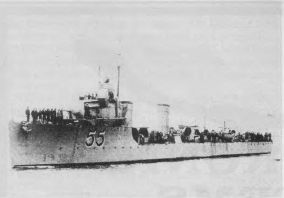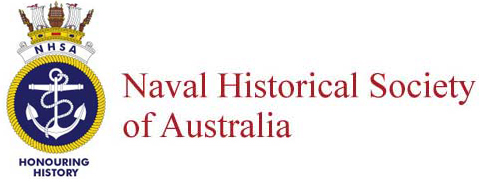- Author
- Ramsay, O.G.
- Subjects
- History - general, Ship design and development
- Tags
-
- RAN Ships
- HMAS Parramatta I, HMAS Tasmania, HMAS Vampire II, HMAS Tobruk I, HMAS Quadrant, HMAS Hobart II, HMAS Success I, HMAS Stalwart I, HMAS Tattoo, HMAS Norman I, HMAS Torrens I, HMAS Duchess, HMAS Quality, HMAS Voyager II, HMAS Quiberon, HMAS Perth III, HMAS Swordsman, HMAS Waterhen, HMAS Anzac II, HMAS Arunta I, HMAS Anzac I, HMAS Hobart I, HMAS Bataan, HMAS Brisbane I, HMAS Brisbane II, HMAS Huon I, HMAS Warrego I, HMAS Yarra I, HMAS Warramunga I, HMAS Voyager I, HMAS Swan I, HMAS Vendetta I, HMAS Vendetta II, HMAS Quickmatch, HMAS Queenborough, HMAS Vampire I, HMAS Napier, HMAS Nepal, HMAS Nestor, HMAS Stuart I, HMAS Nizam, HMAS Perth II
- Publication
- March 1991 edition of the Naval Historical Review (all rights reserved)
Surely destroyers are the backbone of our Royal Australian Navy. Thirty-nine destroyers have served in the RAN since Foundation in 1911, from our first destroyers – HMA Ships PARRAMATTA (1), and YARRA (1), of only 700 tons, to our latest DDGs PERTH, HOBART and BRISBANE displacing over 4,500 tons.
River Class

Australia’s first destroyers were known as the River Class (I Class in the Royal Navy). The first two, PARRAMATTA and YARRA, were completely built in the UK during 1910/11, with WARREGO 1910/12, built in England, then disassembled and shipped to Australia to be rebuilt in Cockatoo Island Dockyard in NSW (for the ship building experience). The remaining four were completely built in Cockatoo Island Dockyard – WARREGO 1910/11/12, HUON (laid as DERWENT, but renamed HUON so as not to be confused with HMS DERWENT) 1913/15, TORRENS 1913/15 and SWAN 1915/16. They had a displacement of 700 tons, length 250ft, beam 24½ft and a 9ft draught. They carried one 4″ gun forward, 3x 12pdrs, 3×18″ torpedoes in tubes. Speed of 26/27 knots, with a complement of 66 officers and men. The cost of the UK built ships was £81,500, and the Australian built ships £160,000. (How times have changed.)
These ships served in the Mediterranean and the Pacific areas during World War I, and after the War, from 1919 in various duties, and for Naval Reserve training.
Gift Destroyers
In 1919 the RAN received six gift destroyers from the Royal Navy, the first was HMAS ANZAC (1), 1917 to 1933, a Marksman (Destroyer leader) Class destroyer of 1,660 tons, length 325ft, beam 31½ft, draught 12½ft, with three funnels. Her armament was 4×4″ guns, 2x12pdrs, 4×21″ torpedoes. She had a speed of 34 knots from her triple screws, with a complement of 122 officers and ratings. ANZAC transferred to the RAN, leaving Plymouth (England) in February 1920 and sailed to Sydney, arriving there on 29 April. There was little to do after the War (Great War), and she spent her time on the Australian east coast, though she visited New Guinea and New Britain in 1924, 1926 and 1930. But she remained the only destroyer kept through the depression years, till she was paid off in 1933, and scrapped in 1935. Sold for £1,800, ANZAC was sunk off Sydney on 7 May 1936 as target practice for RAN ships.
S Class
The other five S Class Destroyers – HMA Ships STALWART (1), SUCCESS, SWORDSMAN, TASMANIA and TATTOO were of 1,070 tons, 276ft in length, beam 26¾ft, draught 10½ft, with 3×4″ guns, 1x2pdr, pompoms and machine guns, 4×21″ torpedoes, speed 34 knots and complement of 90 officers and ratings.
For these ships, the majority of their service life was spent in port, and on the east coast, the only exception being TASMANIA, which visited New Guinea in 1924.
These S Class were famous ships, and over sixty more were built for the Royal Navy to replace WW I ships, and though many were scrapped between the wars, eleven still served in the Royal Navy during WW II.
The RAN’s five were built in the UK 1917/18, and commissioned into the RAN 1920. They paid off and went to Reserve in the late 1920s to 1930, and were all sold by 1937.
TATTOO was the last to pay off in 1933. On one of its last trips outside Sydney’s Heads, when passing the Matson Liner MARIPOSA, it signalled ‘Are you catching any fish’. Poor TATTOO! At least – they claimed – TATTOO never broke down.
V&W Class
Next, after service with the Royal Navy from 1918 to 1932, STUART transferred to the Royal Australian Navy in October 1933, along with four V & W Class destroyers (to replace the old S Class destroyers).
HMAS STUART (1) was a Scott Class Destroyer Leader, with displacement of 2,000 tons, length 332ft, beam 31¾ft, draught 12¼ft. Her armament (original) was 5×4.7″ guns, 1×3″ AA and small arms, and 6×21″ torpedoes. Speed 36½ knots and ship’s complement of 185. In her RAN commission, she was the Flotilla Leader, and up to 1939 served mainly in Australian waters, though being decommissioned for two short periods in that time.
With the declaration of war in 1939, STUART (Cmdr H.M.L. Waller, RAN), with the V & Ws HMA Ships VAMPIRE (1), VENDETTA (1), VOYAGER (1), and WATERHEN (1), sailed for the Mediterranean, where the Flotilla saw much action along the North African coast, with the British Fleet all over the Eastern Mediterranean, and with HMAS SYDNEY in action against the Italian Fleet at Calabria, through to the Battle of Matapan, then landings of troops on Greece and Crete, and later evacuating those troops after German occupation. STUART departed the Mediterranean August 22nd 1941, to return to Australia to commence a long and overdue refit, till April 1942. She then served in north eastern Australian waters till 1946, paying off 27th April 1946 and was scrapped in 1947.
